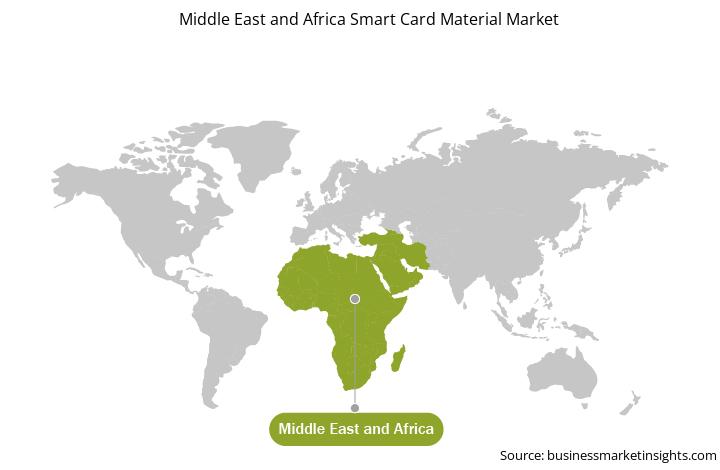There is a growing focus on making smart card from more renewable resources. Many companies across the region are focusing on developing a new product that contains less plastic. Bio-based plastic material is a new and emerging subset of conventional plastic for producing smart cards. LUC-BIO is one such material which is a green form of PVC developed to meet the growing demand for green products. Universal Smart Cards Inc. produces smart cards using this material. One major manufacturer has created radio-frequency identification (RFID) cards and smart cards with bio-based materials. The end use industries are demanding for the smart cards made of biodegradable materials to maintain the eco-sustainability of their products and to comply with the nation’s guidelines. Thus, the increasing focus on the development of bio-based material would emerge as a trend in the smart card materials market during the forecast period.
In the Middle East and Africa region, South Africa is among the major countries with a high number of COVID-19 confirmed cases and deaths. The COVID-19 pandemic has had a severe impact on the economy of the Middle East & Africa. The pandemic has significantly slowed down the growth of the smart card materials market in the region due to negative impacts upon the growth of various industries. The COVID-19 pandemic has impacted the retail and hospitality industry. As a result of lockdowns and stay-at-home orders, the customer footprints has been reduced. The demand for smart card materials in the region will depend upon the evolution of the epidemic, vaccination plans, and economic recovery.
With the new features and technologies, vendors can attract new customers and expand their footprints in emerging markets. This factor is likely to drive the smart card material market. The MEA smart card material market is expected to grow at a good CAGR during the forecast period.
Strategic insights for the Middle East and Africa Smart Card Material provides data-driven analysis of the industry landscape, including current trends, key players, and regional nuances. These insights offer actionable recommendations, enabling readers to differentiate themselves from competitors by identifying untapped segments or developing unique value propositions. Leveraging data analytics, these insights help industry players anticipate the market shifts, whether investors, manufacturers, or other stakeholders. A future-oriented perspective is essential, helping stakeholders anticipate market shifts and position themselves for long-term success in this dynamic region. Ultimately, effective strategic insights empower readers to make informed decisions that drive profitability and achieve their business objectives within the market.

| Report Attribute | Details |
|---|---|
| Market size in 2021 | US$ 54.97 Million |
| Market Size by 2028 | US$ 72.44 Million |
| Global CAGR (2021 - 2028) | 4.0% |
| Historical Data | 2019-2020 |
| Forecast period | 2022-2028 |
| Segments Covered |
By Material
|
| Regions and Countries Covered | Middle East and Africa
|
| Market leaders and key company profiles |
The geographic scope of the Middle East and Africa Smart Card Material refers to the specific areas in which a business operates and competes. Understanding local distinctions, such as diverse consumer preferences (e.g., demand for specific plug types or battery backup durations), varying economic conditions, and regulatory environments, is crucial for tailoring strategies to specific markets. Businesses can expand their reach by identifying underserved areas or adapting their offerings to meet local demands. A clear market focus allows for more effective resource allocation, targeted marketing campaigns, and better positioning against local competitors, ultimately driving growth in those targeted areas.

The Middle East and Africa Smart Card Material Market is valued at US$ 54.97 Million in 2021, it is projected to reach US$ 72.44 Million by 2028.
As per our report Middle East and Africa Smart Card Material Market, the market size is valued at US$ 54.97 Million in 2021, projecting it to reach US$ 72.44 Million by 2028. This translates to a CAGR of approximately 4.0% during the forecast period.
The Middle East and Africa Smart Card Material Market report typically cover these key segments-
The historic period, base year, and forecast period can vary slightly depending on the specific market research report. However, for the Middle East and Africa Smart Card Material Market report:
The Middle East and Africa Smart Card Material Market is populated by several key players, each contributing to its growth and innovation. Some of the major players include:
The Middle East and Africa Smart Card Material Market report is valuable for diverse stakeholders, including:
Essentially, anyone involved in or considering involvement in the Middle East and Africa Smart Card Material Market value chain can benefit from the information contained in a comprehensive market report.